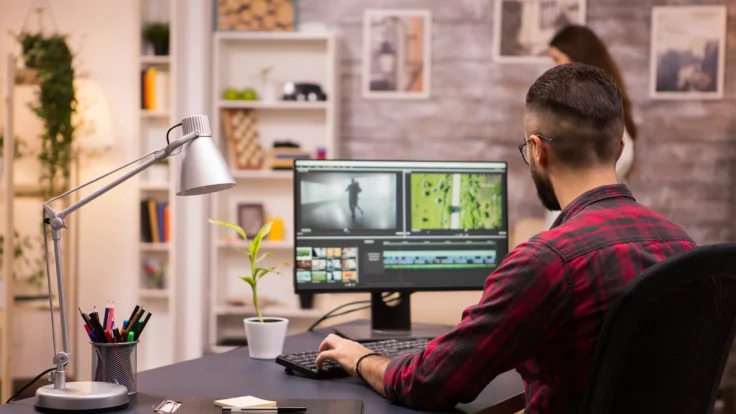The demand for remote art jobs has surged in recent years, and it’s easy to see why. As companies worldwide embrace digital platforms, they’re increasingly seeking talented artists to work from home. From graphic design to 3D animation, the remote art industry offers a wide range of opportunities for creatives to showcase their talents and build successful careers. Whether you’re an experienced designer or someone just getting started in the world of art, remote art jobs offer flexibility, independence, and the potential for growth.
In addition to offering flexibility, remote art jobs allow artists to work with clients and companies from all over the world. This global reach enables creatives to collaborate on exciting and diverse projects, from game design to advertising campaigns. The opportunity to work remotely not only gives artists the freedom to choose their projects but also allows them to create in an environment that fosters creativity and innovation. For many artists, remote work is the perfect blend of personal freedom and professional growth.
Types of Remote Art Jobs Available
Remote art jobs cover a broad spectrum of roles, each requiring different skill sets and creative abilities. One of the most common positions in the remote art world is graphic design. Graphic designers are responsible for creating visual content for websites, branding, logos, marketing materials, and more. With the rise of digital media, remote graphic design jobs are more in demand than ever, offering full-time, part-time, and freelance opportunities.
Another growing area of remote art jobs is digital art. Digital artists use specialized tools like tablets and drawing software to create original artwork. This can include everything from illustrations and concept art to character designs for video games and films. These remote art jobs often offer a high degree of creative freedom, allowing artists to experiment with new techniques and styles. As the demand for digital art increases in industries like entertainment, marketing, and publishing, so too do the opportunities for remote digital artists.
Animation and 3D art jobs are also available remotely, offering exciting opportunities for creative professionals in these fields. 3D artists create digital models and animations for everything from movies to video games, while animators bring characters and stories to life through movement. Remote 3D and animation roles often require proficiency in industry-standard software like Blender, Maya, or Cinema 4D. With advancements in technology, these jobs are becoming more accessible to artists worldwide, allowing them to work from home while contributing to high-profile projects.
Freelance remote art jobs are another avenue for artists looking for flexible work. Freelancers have the freedom to choose their clients and set their schedules, making it a great option for those who prefer autonomy in their work. Freelance art jobs can range from logo design to full-length illustrations or 3D models. Websites like Upwork, Fiverr, and Freelancer offer a variety of freelance opportunities, enabling artists to connect with clients around the globe and build their portfolios over time.
Entry-Level Remote Art Jobs: How to Break Into the Industry
Entering the world of remote art jobs doesn’t require years of experience or a formal degree. In fact, many entry-level remote art jobs are available for beginners who are willing to learn and develop their skills. The key to securing a remote art job at the entry level is creating a strong portfolio that showcases your work, even if it’s self-taught. There are numerous online courses, tutorials, and resources that can help you learn the basics of graphic design, illustration, and animation.
Once you have a solid foundation, platforms like Upwork, Fiverr, and Freelancer provide a great starting point for securing remote art jobs. These freelance platforms allow you to bid on smaller projects, which is ideal for building a portfolio and gaining experience. By taking on entry-level remote art jobs, you can gradually work your way up to more complex and higher-paying positions. The more projects you complete, the more your portfolio will grow, and your credibility will increase.
While it may take some time to land your first remote art job, perseverance is key. Many artists begin their careers by taking on low-paying or small-scale projects before working their way up to bigger roles. As you gain more experience and refine your craft, you’ll have the opportunity to take on higher-profile projects that can boost your reputation in the industry. Whether you’re just starting or transitioning into remote work, entry-level remote art jobs can be a great way to begin your journey.
No Experience, No Degree: Remote Art Jobs for Beginners

One of the most appealing aspects of remote art jobs is that many positions don’t require formal qualifications or years of experience. In the creative field, skills, talent, and portfolio quality often matter more than formal education. This opens the door for those with little or no experience to find remote art jobs, provided they have the drive to learn and grow.
For beginners, there are plenty of remote art jobs available that do not require a degree or professional background. Many companies value creativity and innovation, offering opportunities for artists to showcase their skills regardless of their education. For those without a degree, focusing on building a strong portfolio is critical. Whether you’re into digital illustration, graphic design, or animation, a well-curated portfolio can often be more valuable than a degree when applying for remote art jobs.
Additionally, various online platforms and resources are available to help you learn the necessary skills. Online learning platforms like Skillshare, Udemy, and Coursera offer courses in everything from basic graphic design to advanced animation techniques. By taking advantage of these resources, beginners can quickly gain the skills needed to succeed in the remote art industry, even without formal education or experience.
Best Places to Find Remote Art Jobs
Finding remote art jobs has never been easier, thanks to a variety of online job boards and freelance platforms. Websites like LinkedIn, Indeed, and FlexJobs provide dedicated sections for remote art jobs, allowing you to filter your search based on location, experience level, and job type. These platforms offer a range of remote positions, from full-time roles to part-time and freelance opportunities, ensuring that artists of all levels can find something that suits their skills and preferences.
Freelance platforms like Upwork, Fiverr, and Twine are great for finding short-term or project-based remote art jobs. These sites connect artists with clients from all over the world, making it easy to find work, build a portfolio, and establish a reputation. Additionally, these platforms allow you to set your rates and work at your own pace, making them perfect for freelance remote art jobs.
If you’re looking for remote art jobs in specific locations, like New York City, Toronto, or the UK, job boards such as We Work Remotely and Remote OK can help you find roles that match your criteria. These sites specialize in remote work listings and allow you to search for opportunities based on your location and preferred industry. No matter where you’re located, remote art jobs offer the flexibility to work from anywhere, opening up countless possibilities for creatives.
Benefits of Remote Art Jobs: Flexibility, Creativity, and Growth
Remote art jobs offer numerous benefits, making them an attractive option for artists seeking a balanced lifestyle. One of the biggest advantages of working remotely is the flexibility it provides. Artists can set their schedules, allowing them to work during their most productive hours. Whether you prefer to work early in the morning or late at night, remote art jobs give you the freedom to work when it suits you best.
In addition to flexibility, remote art jobs encourage creativity. Working from home in a comfortable environment often allows artists to produce their best work, as they can tailor their workspace to their own preferences. The freedom to choose which projects to take on and the ability to collaborate with clients worldwide further fuel artistic creativity. Remote art jobs offer opportunities to work on exciting, diverse projects that push the boundaries of your skills and imagination.
Lastly, remote art jobs provide opportunities for professional growth. As remote work becomes more common in the art industry, there are more chances to work on high-profile projects and collaborate with other creatives from around the world. These experiences can help you expand your portfolio, improve your skills, and advance your career.
Conclusion: Embracing the Future of Remote Art Careers
The future of remote art jobs is bright, with increasing demand for skilled artists in various creative fields. Whether you’re looking to work as a graphic designer, digital illustrator, or animator, there are abundant opportunities for artists to thrive in the remote work landscape. With the flexibility to work from anywhere and the freedom to choose your projects, remote art jobs offer a perfect balance of creativity and independence. As the industry continues to grow, the potential for career advancement and personal fulfillment in remote art jobs is limitless.
FAQs:
- What are the best platforms to find remote art jobs?
- Do I need a degree to apply for remote art jobs?
- How do I get started with entry-level remote art jobs?
- Can I find remote art jobs in my local area?
- Are freelance remote art jobs a good career choice?
- What skills do I need to land a remote art job with no experience?
- How can I build a portfolio for remote art job applications?
- What are the top remote art jobs in Canada, the UK, and the US?
- How flexible are part-time remote art jobs?
- Can I find remote art jobs in the animation and 3D design fields?
you may also read: Who is Vincenzo Grifo?



